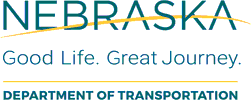Nebraska Local Technical Assistance Program

Nebraska Department of Transportation: Research Reports
Date of this Version
5-31-2023
Document Type
Article
Citation
Khattak, A., Camenzind, J., and Shakiul Haque, MM. (2023). Inventory, Operations, and Safety at Free Right-Turn Ramps. NDOT Research Report SPR-FY22(012).
Abstract
This research focused on traffic safety and operational performance of rural, minor approach stop-controlled intersections with free right-turn (FRT) ramps. The objectives of the research were to:
- Create a statewide inventory of rural FRT ramp intersections and provide to the Nebraska Department of Transportation (NDOT),
- Using NDOT 10-year crash data, conduct statistical safety analysis of rural FRT intersections extending ¼-mile in each direction from the intersection,
- Study vehicular operations at rural intersections with and without FRT ramps including a comparison of vehicular conflicts, and
- Develop guidelines for operations and safety tradeoffs to assist with NDOT projects on maintaining similar locations, removing, or reconstructing ramps.
As of 2023, 79 FRT ramps exist at 68 rural highway intersections in Nebraska. FRT ramps may be located on three-legged or four-legged intersections and may be on the minor, the major, or both minor and major approaches of the same intersection. The research statistically compared the 68 rural FRT ramp intersections to 24 similar non-FRT rural intersections to identify differences in crash frequencies and crash rates using 2010-2019 crash data from NDOT. The analysis did not show any statistically significant differences between the two intersection groups. This result is identical to a 1995 Nebraska-based study of rural FRT ramp intersection safety.
The research investigated vehicular conflicts between right-turning vehicles by pairing six non-FRT intersections with six FRT ramp intersections and collecting data using video recording equipment. The comparison was between vehicular conflicts experienced by right-turning traffic on the same approach of the FRT ramp and non-FRT intersections. Data analysis showed that non-FRT right-turns on the minor approach, major approach with no exclusive right-turn lane, and major approach with an exclusive right-turn lane experienced statistically significantly higher conflicts per 1,000 entering right-turning vehicles than FRT ramp intersections.
A VISSIM microsimulation model of traffic operations at FRT ramp intersections and non-FRT intersections enabled the creation of 324 scenarios, based on varying traffic and roadway geometry. Assuming a 20-year lifespan, benefit cost (B/C) analysis was conducted for combinations of discount rates (4%, 6%, and 8%), major road Annual Average Daily Traffic (AADT) (5,000; 10,000; 15,000), minor road AADT (2,500; 5,000; 7,500), percent right turning traffic (10%, 25%, 50%), FRT ramp radius in feet (650; 1,200; 1,800) and speed limit in mph (45, 55, 65). Traffic operational benefits are the basis for considering FRT ramp construction, reconstruction, or removal at rural, minor approach stop-controlled intersections in Nebraska. The reason is the absence of any discernable differences in the crashes at FRT ramp and comparable non-FRT intersections. NDOT can make more informed decisions on FRT ramp intersections based on guidance in this report.

